Report on Internal Recruitment of a Software Developer for Sysplus
VerifiedAdded on 2019/09/30
|6
|893
|356
Report
AI Summary
This report provides an in-depth analysis of the internal recruitment process for a software developer position within Sysplus. It outlines the roadmap for recruitment, including strategy development, candidate searching, and system development, while also addressing legal considerations. The report details the targeted KSAOs (Knowledge, Skills, Abilities, and Other characteristics) required for the role, emphasizing the importance of software proficiency and the ability to work on different systems. It explores the internal recruitment strategy, including open and closed recruitment methods, target groups, and various recruitment sources like job postings and employee referrals. Furthermore, the report discusses the communication message, focusing on targeted, realistic, and branded messaging, as well as the communication mediums used for internal recruitment. References to relevant literature are also included.
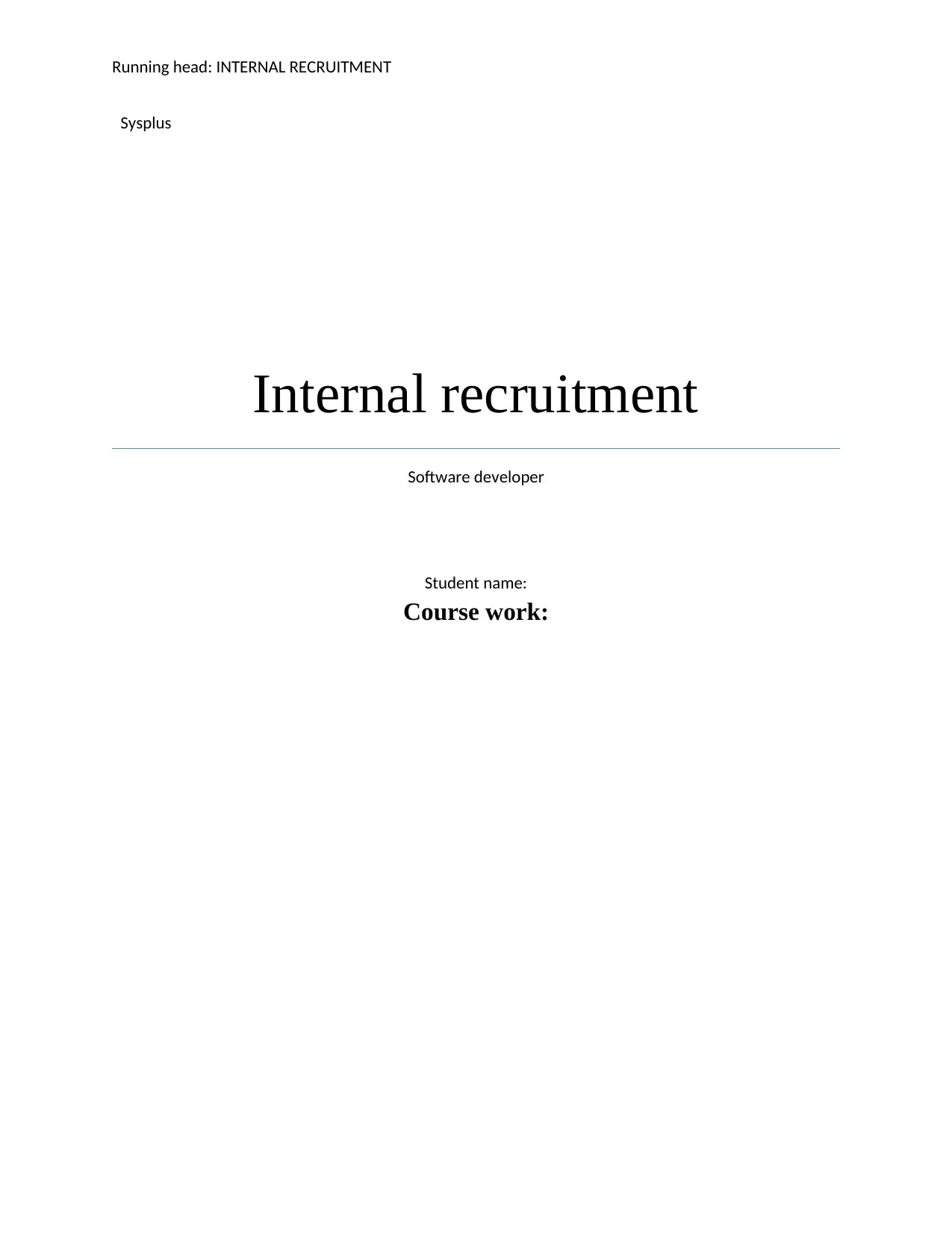
Running head: INTERNAL RECRUITMENT
Sysplus
Internal recruitment
Software developer
Student name:
Course work:
Sysplus
Internal recruitment
Software developer
Student name:
Course work:
Paraphrase This Document
Need a fresh take? Get an instant paraphrase of this document with our AI Paraphraser
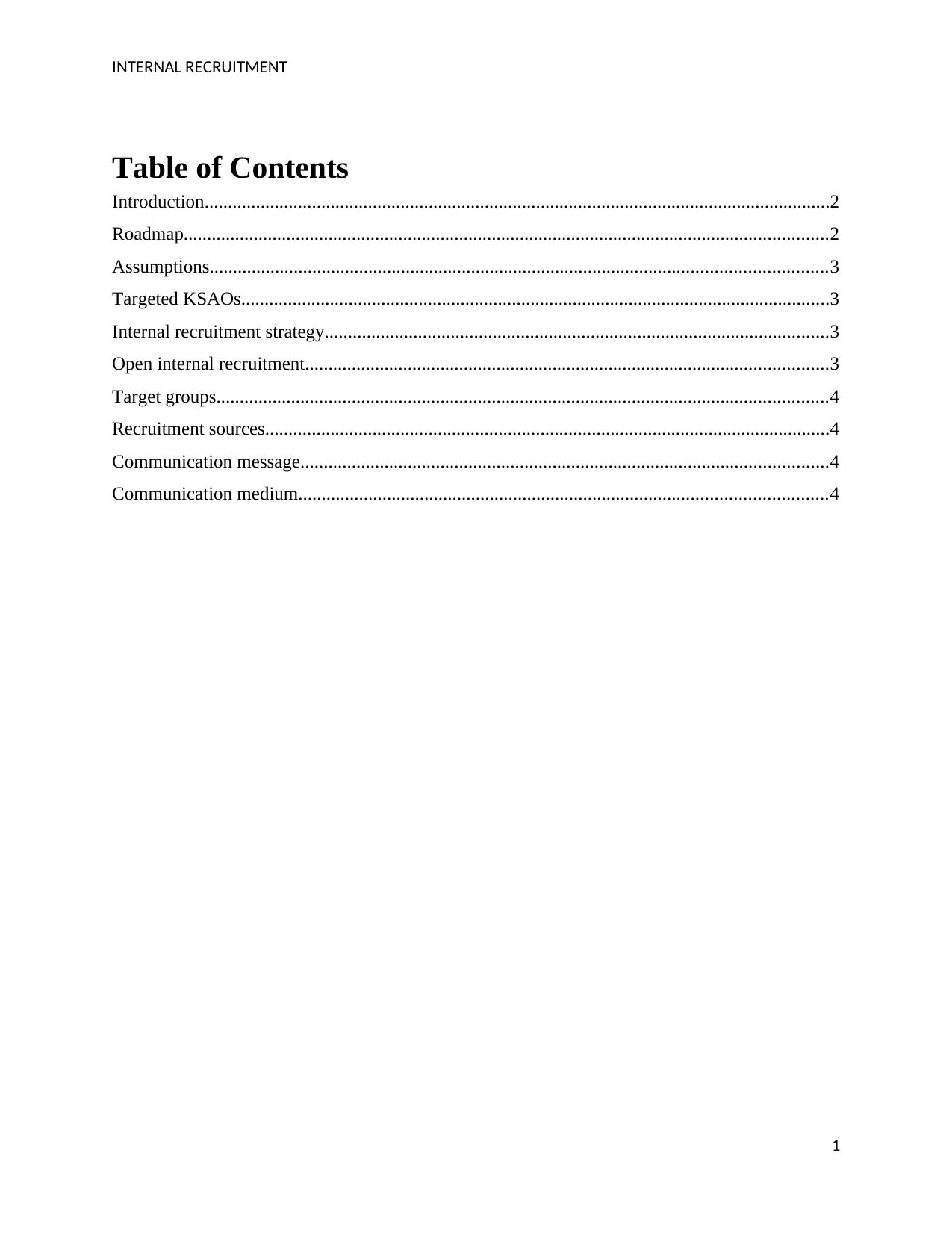
INTERNAL RECRUITMENT
Table of Contents
Introduction......................................................................................................................................2
Roadmap..........................................................................................................................................2
Assumptions....................................................................................................................................3
Targeted KSAOs..............................................................................................................................3
Internal recruitment strategy............................................................................................................3
Open internal recruitment................................................................................................................3
Target groups...................................................................................................................................4
Recruitment sources.........................................................................................................................4
Communication message.................................................................................................................4
Communication medium.................................................................................................................4
1
Table of Contents
Introduction......................................................................................................................................2
Roadmap..........................................................................................................................................2
Assumptions....................................................................................................................................3
Targeted KSAOs..............................................................................................................................3
Internal recruitment strategy............................................................................................................3
Open internal recruitment................................................................................................................3
Target groups...................................................................................................................................4
Recruitment sources.........................................................................................................................4
Communication message.................................................................................................................4
Communication medium.................................................................................................................4
1
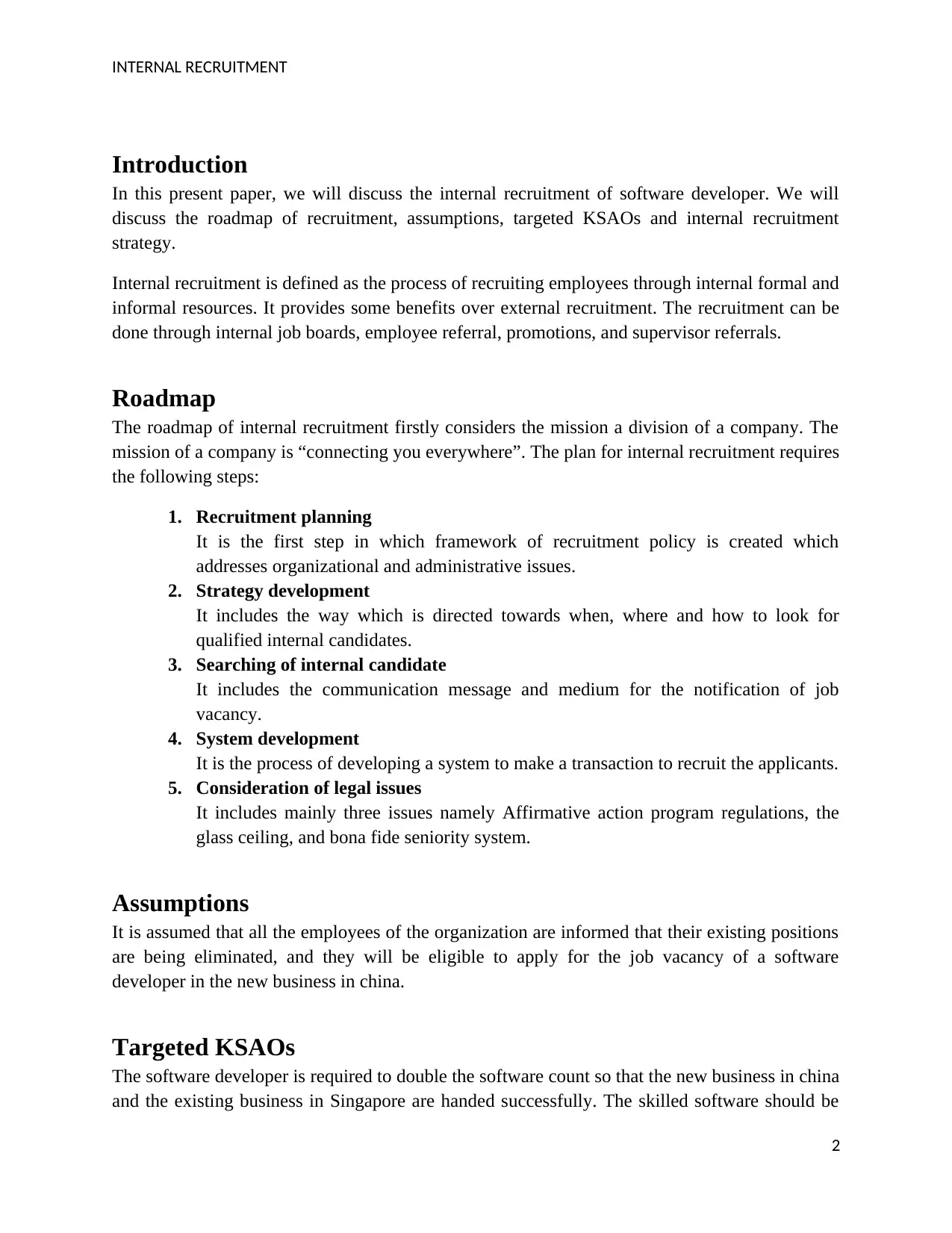
INTERNAL RECRUITMENT
Introduction
In this present paper, we will discuss the internal recruitment of software developer. We will
discuss the roadmap of recruitment, assumptions, targeted KSAOs and internal recruitment
strategy.
Internal recruitment is defined as the process of recruiting employees through internal formal and
informal resources. It provides some benefits over external recruitment. The recruitment can be
done through internal job boards, employee referral, promotions, and supervisor referrals.
Roadmap
The roadmap of internal recruitment firstly considers the mission a division of a company. The
mission of a company is “connecting you everywhere”. The plan for internal recruitment requires
the following steps:
1. Recruitment planning
It is the first step in which framework of recruitment policy is created which
addresses organizational and administrative issues.
2. Strategy development
It includes the way which is directed towards when, where and how to look for
qualified internal candidates.
3. Searching of internal candidate
It includes the communication message and medium for the notification of job
vacancy.
4. System development
It is the process of developing a system to make a transaction to recruit the applicants.
5. Consideration of legal issues
It includes mainly three issues namely Affirmative action program regulations, the
glass ceiling, and bona fide seniority system.
Assumptions
It is assumed that all the employees of the organization are informed that their existing positions
are being eliminated, and they will be eligible to apply for the job vacancy of a software
developer in the new business in china.
Targeted KSAOs
The software developer is required to double the software count so that the new business in china
and the existing business in Singapore are handed successfully. The skilled software should be
2
Introduction
In this present paper, we will discuss the internal recruitment of software developer. We will
discuss the roadmap of recruitment, assumptions, targeted KSAOs and internal recruitment
strategy.
Internal recruitment is defined as the process of recruiting employees through internal formal and
informal resources. It provides some benefits over external recruitment. The recruitment can be
done through internal job boards, employee referral, promotions, and supervisor referrals.
Roadmap
The roadmap of internal recruitment firstly considers the mission a division of a company. The
mission of a company is “connecting you everywhere”. The plan for internal recruitment requires
the following steps:
1. Recruitment planning
It is the first step in which framework of recruitment policy is created which
addresses organizational and administrative issues.
2. Strategy development
It includes the way which is directed towards when, where and how to look for
qualified internal candidates.
3. Searching of internal candidate
It includes the communication message and medium for the notification of job
vacancy.
4. System development
It is the process of developing a system to make a transaction to recruit the applicants.
5. Consideration of legal issues
It includes mainly three issues namely Affirmative action program regulations, the
glass ceiling, and bona fide seniority system.
Assumptions
It is assumed that all the employees of the organization are informed that their existing positions
are being eliminated, and they will be eligible to apply for the job vacancy of a software
developer in the new business in china.
Targeted KSAOs
The software developer is required to double the software count so that the new business in china
and the existing business in Singapore are handed successfully. The skilled software should be
2
⊘ This is a preview!⊘
Do you want full access?
Subscribe today to unlock all pages.

Trusted by 1+ million students worldwide

INTERNAL RECRUITMENT
good at writing programs because they are very crucial, and bad programs are having a problem
of bugs which directly impact on the goodwill of a company. The reputation building is very
necessary for the new business in china. The main KSOs require the ability to work on different
system applications, good knowledge of Sys plus, review and analyzing capabilities.
Internal recruitment strategy
The internal recruitment strategy is required to locate viable internal job applicants. The strategy
is conducted within the constraint of general eligibility criteria for flexibility in the process
(DeVaro et al., 2013). It includes closed, open internal recruitment and targeted groups.
Following are the steps of closed internal recruitment system:
1. The notification of human resource vacancy by the manager
2. Searching of candidates files by human resources
3. Shortlisted candidates list given to the manager of human resources
4. Interview conduct by manager
5. Candidates selected for the position of software developer
Open internal recruitment
It is mainly used to create awareness about the job vacancy in an organization. Following are the
steps used for open internal recruitment system:
1. Manager notifies the vacancy of human resource
2. Position open for human resource
3. Interested applicants send bids to the human resource
4. Screening of applicants by human resource
5. Interview conduct by managers
6. Positions filled by managers
Target groups
It follows by both open and closed internal recruitment. The search is conducted outside the job
posting system in which large applications are received which is shortlisted on the basis of
KROs. It is basically a meeting HR council discusses the open positions and internal candidates
of a company which helps to identify the right candidate internally (Hampson et al., 2015).
Recruitment sources
The recruitment sources include job postings, nominations, skills inventory, in-house temporary
pool, employee referral, intranet and intra-placement, and replacement and succession plans.
3
good at writing programs because they are very crucial, and bad programs are having a problem
of bugs which directly impact on the goodwill of a company. The reputation building is very
necessary for the new business in china. The main KSOs require the ability to work on different
system applications, good knowledge of Sys plus, review and analyzing capabilities.
Internal recruitment strategy
The internal recruitment strategy is required to locate viable internal job applicants. The strategy
is conducted within the constraint of general eligibility criteria for flexibility in the process
(DeVaro et al., 2013). It includes closed, open internal recruitment and targeted groups.
Following are the steps of closed internal recruitment system:
1. The notification of human resource vacancy by the manager
2. Searching of candidates files by human resources
3. Shortlisted candidates list given to the manager of human resources
4. Interview conduct by manager
5. Candidates selected for the position of software developer
Open internal recruitment
It is mainly used to create awareness about the job vacancy in an organization. Following are the
steps used for open internal recruitment system:
1. Manager notifies the vacancy of human resource
2. Position open for human resource
3. Interested applicants send bids to the human resource
4. Screening of applicants by human resource
5. Interview conduct by managers
6. Positions filled by managers
Target groups
It follows by both open and closed internal recruitment. The search is conducted outside the job
posting system in which large applications are received which is shortlisted on the basis of
KROs. It is basically a meeting HR council discusses the open positions and internal candidates
of a company which helps to identify the right candidate internally (Hampson et al., 2015).
Recruitment sources
The recruitment sources include job postings, nominations, skills inventory, in-house temporary
pool, employee referral, intranet and intra-placement, and replacement and succession plans.
3
Paraphrase This Document
Need a fresh take? Get an instant paraphrase of this document with our AI Paraphraser
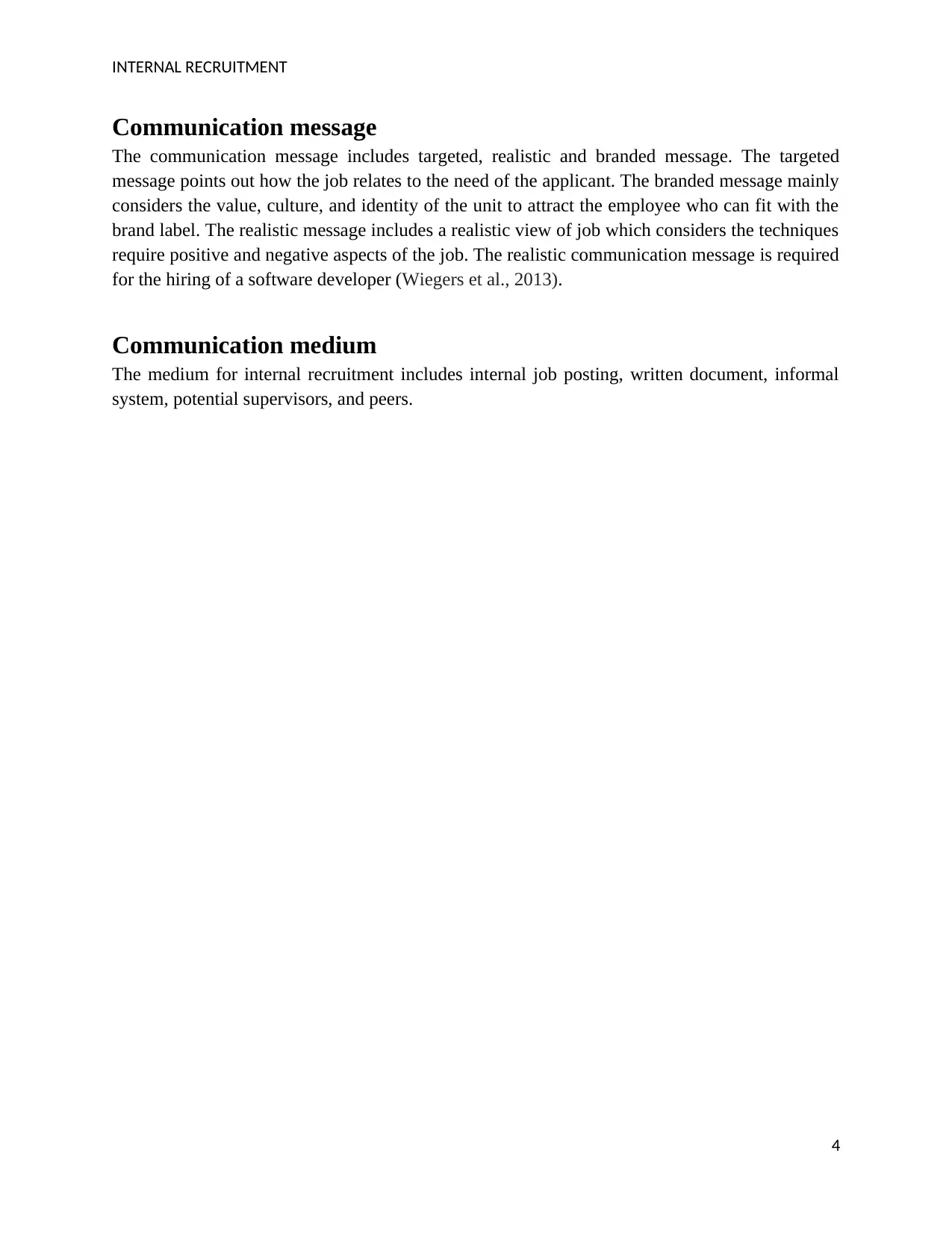
INTERNAL RECRUITMENT
Communication message
The communication message includes targeted, realistic and branded message. The targeted
message points out how the job relates to the need of the applicant. The branded message mainly
considers the value, culture, and identity of the unit to attract the employee who can fit with the
brand label. The realistic message includes a realistic view of job which considers the techniques
require positive and negative aspects of the job. The realistic communication message is required
for the hiring of a software developer (Wiegers et al., 2013).
Communication medium
The medium for internal recruitment includes internal job posting, written document, informal
system, potential supervisors, and peers.
4
Communication message
The communication message includes targeted, realistic and branded message. The targeted
message points out how the job relates to the need of the applicant. The branded message mainly
considers the value, culture, and identity of the unit to attract the employee who can fit with the
brand label. The realistic message includes a realistic view of job which considers the techniques
require positive and negative aspects of the job. The realistic communication message is required
for the hiring of a software developer (Wiegers et al., 2013).
Communication medium
The medium for internal recruitment includes internal job posting, written document, informal
system, potential supervisors, and peers.
4
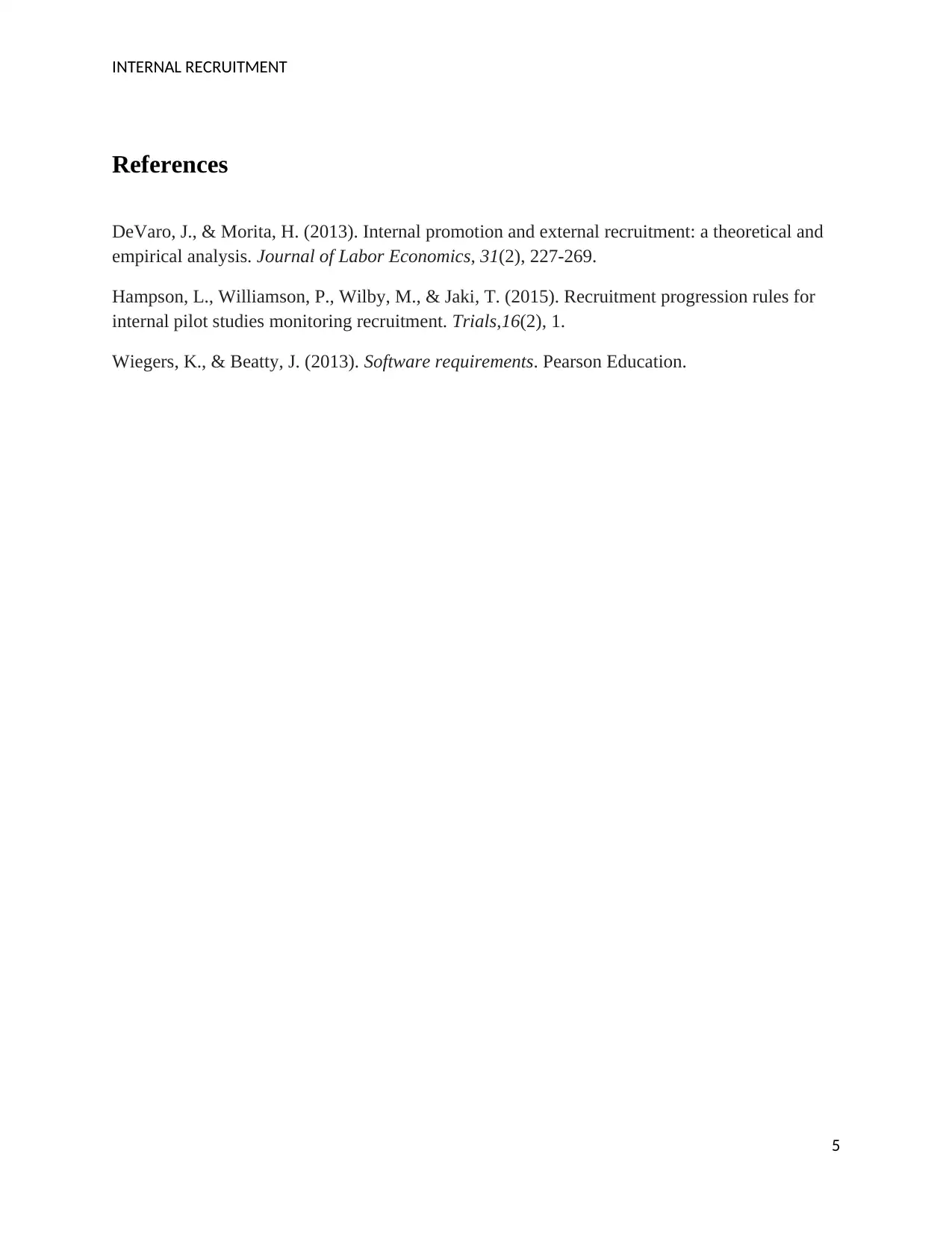
INTERNAL RECRUITMENT
References
DeVaro, J., & Morita, H. (2013). Internal promotion and external recruitment: a theoretical and
empirical analysis. Journal of Labor Economics, 31(2), 227-269.
Hampson, L., Williamson, P., Wilby, M., & Jaki, T. (2015). Recruitment progression rules for
internal pilot studies monitoring recruitment. Trials,16(2), 1.
Wiegers, K., & Beatty, J. (2013). Software requirements. Pearson Education.
5
References
DeVaro, J., & Morita, H. (2013). Internal promotion and external recruitment: a theoretical and
empirical analysis. Journal of Labor Economics, 31(2), 227-269.
Hampson, L., Williamson, P., Wilby, M., & Jaki, T. (2015). Recruitment progression rules for
internal pilot studies monitoring recruitment. Trials,16(2), 1.
Wiegers, K., & Beatty, J. (2013). Software requirements. Pearson Education.
5
⊘ This is a preview!⊘
Do you want full access?
Subscribe today to unlock all pages.

Trusted by 1+ million students worldwide
1 out of 6
Related Documents
Your All-in-One AI-Powered Toolkit for Academic Success.
+13062052269
info@desklib.com
Available 24*7 on WhatsApp / Email
![[object Object]](/_next/static/media/star-bottom.7253800d.svg)
Unlock your academic potential
Copyright © 2020–2025 A2Z Services. All Rights Reserved. Developed and managed by ZUCOL.





